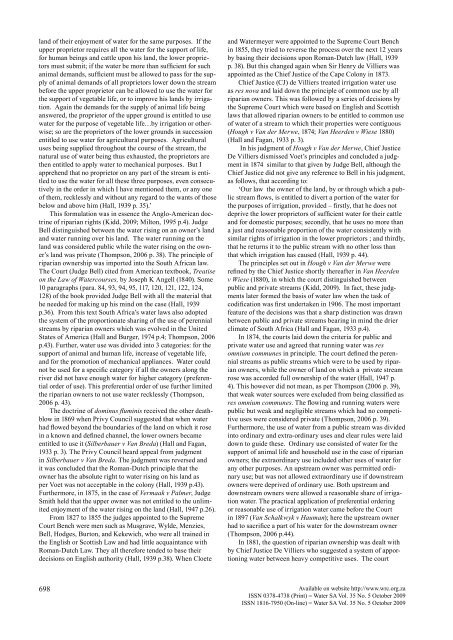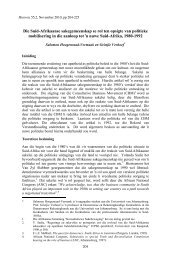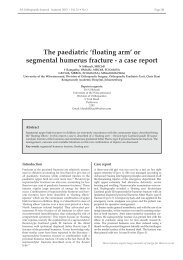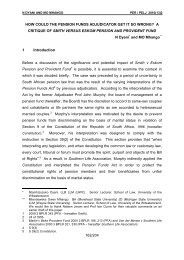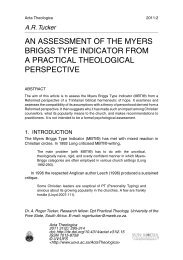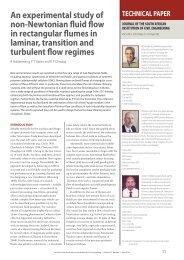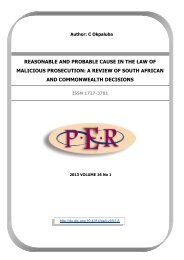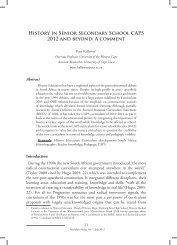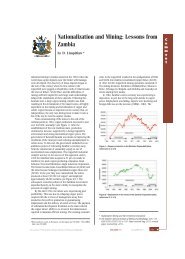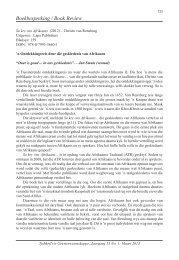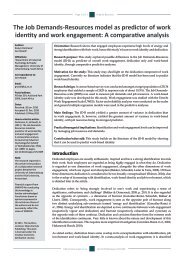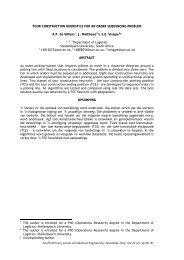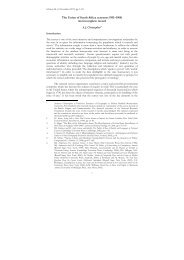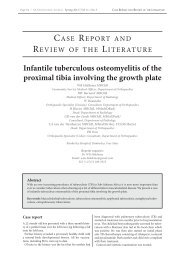A detailed analysis of evolution of water rights in South Africa: An ...
A detailed analysis of evolution of water rights in South Africa: An ...
A detailed analysis of evolution of water rights in South Africa: An ...
You also want an ePaper? Increase the reach of your titles
YUMPU automatically turns print PDFs into web optimized ePapers that Google loves.
land <strong>of</strong> their enjoyment <strong>of</strong> <strong>water</strong> for the same purposes. If the<br />
upper proprietor requires all the <strong>water</strong> for the support <strong>of</strong> life,<br />
for human be<strong>in</strong>gs and cattle upon his land, the lower proprietors<br />
must submit; if the <strong>water</strong> be more than sufficient for such<br />
animal demands, sufficient must be allowed to pass for the supply<br />
<strong>of</strong> animal demands <strong>of</strong> all proprietors lower down the stream<br />
before the upper proprietor can be allowed to use the <strong>water</strong> for<br />
the support <strong>of</strong> vegetable life, or to improve his lands by irrigation.<br />
Aga<strong>in</strong> the demands for the supply <strong>of</strong> animal life be<strong>in</strong>g<br />
answered, the proprietor <strong>of</strong> the upper ground is entitled to use<br />
<strong>water</strong> for the purpose <strong>of</strong> vegetable life…by irrigation or otherwise;<br />
so are the proprietors <strong>of</strong> the lower grounds <strong>in</strong> succession<br />
entitled to use <strong>water</strong> for agricultural purposes. Agricultural<br />
uses be<strong>in</strong>g supplied throughout the course <strong>of</strong> the stream, the<br />
natural use <strong>of</strong> <strong>water</strong> be<strong>in</strong>g thus exhausted, the proprietors are<br />
then entitled to apply <strong>water</strong> to mechanical purposes. But I<br />
apprehend that no proprietor on any part <strong>of</strong> the stream is entitled<br />
to use the <strong>water</strong> for all these three purposes, even consecutively<br />
<strong>in</strong> the order <strong>in</strong> which I have mentioned them, or any one<br />
<strong>of</strong> them, recklessly and without any regard to the wants <strong>of</strong> those<br />
below and above him (Hall, 1939 p. 35).’<br />
This formulation was <strong>in</strong> essence the <strong>An</strong>glo-American doctr<strong>in</strong>e<br />
<strong>of</strong> riparian <strong>rights</strong> (Kidd, 2009; Milton, 1995 p.4). Judge<br />
Bell dist<strong>in</strong>guished between the <strong>water</strong> ris<strong>in</strong>g on an owner’s land<br />
and <strong>water</strong> runn<strong>in</strong>g over his land. The <strong>water</strong> runn<strong>in</strong>g on the<br />
land was considered public while the <strong>water</strong> ris<strong>in</strong>g on the owner’s<br />
land was private (Thompson, 2006 p. 38). The pr<strong>in</strong>ciple <strong>of</strong><br />
riparian ownership was imported <strong>in</strong>to the <strong>South</strong> <strong>Africa</strong>n law.<br />
The Court (Judge Bell) cited from American textbook, Treatise<br />
on the Law <strong>of</strong> Watercourses, by Joseph K <strong>An</strong>gell (1840). Some<br />
10 paragraphs (para. 84, 93, 94, 95, 117, 120, 121, 122, 124,<br />
128) <strong>of</strong> the book provided Judge Bell with all the material that<br />
he needed for mak<strong>in</strong>g up his m<strong>in</strong>d on the case (Hall, 1939<br />
p.36). From this text <strong>South</strong> <strong>Africa</strong>’s <strong>water</strong> laws also adopted<br />
the system <strong>of</strong> the proportionate shar<strong>in</strong>g <strong>of</strong> the use <strong>of</strong> perennial<br />
streams by riparian owners which was evolved <strong>in</strong> the United<br />
States <strong>of</strong> America (Hall and Burger, 1974 p.4; Thompson, 2006<br />
p.43). Further, <strong>water</strong> use was divided <strong>in</strong>to 3 categories: for the<br />
support <strong>of</strong> animal and human life, <strong>in</strong>crease <strong>of</strong> vegetable life,<br />
and for the promotion <strong>of</strong> mechanical appliances. Water could<br />
not be used for a specific category if all the owners along the<br />
river did not have enough <strong>water</strong> for higher category (preferential<br />
order <strong>of</strong> use). This preferential order <strong>of</strong> use further limited<br />
the riparian owners to not use <strong>water</strong> recklessly (Thompson,<br />
2006 p. 43).<br />
The doctr<strong>in</strong>e <strong>of</strong> dom<strong>in</strong>us flum<strong>in</strong>is received the other deathblow<br />
<strong>in</strong> 1869 when Privy Council suggested that when <strong>water</strong><br />
had flowed beyond the boundaries <strong>of</strong> the land on which it rose<br />
<strong>in</strong> a known and def<strong>in</strong>ed channel, the lower owners became<br />
entitled to use it (Silberbauer v Van Breda) (Hall and Fagan,<br />
1933 p. 3). The Privy Council heard appeal from judgment<br />
<strong>in</strong> Silberbauer v Van Breda. The judgment was reversed and<br />
it was concluded that the Roman-Dutch pr<strong>in</strong>ciple that the<br />
owner has the absolute right to <strong>water</strong> ris<strong>in</strong>g on his land as<br />
per Voet was not acceptable <strong>in</strong> the colony (Hall, 1939 p.43).<br />
Furthermore, <strong>in</strong> 1875, <strong>in</strong> the case <strong>of</strong> Vermaak v Palmer, Judge<br />
Smith held that the upper owner was not entitled to the unlimited<br />
enjoyment <strong>of</strong> the <strong>water</strong> ris<strong>in</strong>g on the land (Hall, 1947 p.26).<br />
From 1827 to 1855 the judges appo<strong>in</strong>ted to the Supreme<br />
Court Bench were men such as Musgrave, Wylde, Menzies,<br />
Bell, Hodges, Burton, and Kekewich, who were all tra<strong>in</strong>ed <strong>in</strong><br />
the English or Scottish Law and had little acqua<strong>in</strong>tance with<br />
Roman-Dutch Law. They all therefore tended to base their<br />
decisions on English authority (Hall, 1939 p.38). When Cloete<br />
and Watermeyer were appo<strong>in</strong>ted to the Supreme Court Bench<br />
<strong>in</strong> 1855, they tried to reverse the process over the next 12 years<br />
by bas<strong>in</strong>g their decisions upon Roman-Dutch law (Hall, 1939<br />
p. 38). But this changed aga<strong>in</strong> when Sir Henry de Villiers was<br />
appo<strong>in</strong>ted as the Chief Justice <strong>of</strong> the Cape Colony <strong>in</strong> 1873.<br />
Chief Justice (CJ) de Villiers treated irrigation <strong>water</strong> use<br />
as res nova and laid down the pr<strong>in</strong>ciple <strong>of</strong> common use by all<br />
riparian owners. This was followed by a series <strong>of</strong> decisions by<br />
the Supreme Court which were based on English and Scottish<br />
laws that allowed riparian owners to be entitled to common use<br />
<strong>of</strong> <strong>water</strong> <strong>of</strong> a stream to which their properties were contiguous<br />
(Hough v Van der Merwe, 1874; Van Heerden v Wiese 1880)<br />
(Hall and Fagan, 1933 p. 3).<br />
In his judgment <strong>of</strong> Hough v Van der Merwe, Chief Justice<br />
De Villiers dismissed Voet’s pr<strong>in</strong>ciples and concluded a judgment<br />
<strong>in</strong> 1874 similar to that given by Judge Bell, although the<br />
Chief Justice did not give any reference to Bell <strong>in</strong> his judgment,<br />
as follows, that accord<strong>in</strong>g to:<br />
‘Our law the owner <strong>of</strong> the land, by or through which a public<br />
stream flows, is entitled to divert a portion <strong>of</strong> the <strong>water</strong> for<br />
the purposes <strong>of</strong> irrigation, provided – firstly, that he does not<br />
deprive the lower proprietors <strong>of</strong> sufficient <strong>water</strong> for their cattle<br />
and for domestic purposes; secondly, that he uses no more than<br />
a just and reasonable proportion <strong>of</strong> the <strong>water</strong> consistently with<br />
similar <strong>rights</strong> <strong>of</strong> irrigation <strong>in</strong> the lower proprietors ; and thirdly,<br />
that he returns it to the public stream with no other loss than<br />
that which irrigation has caused (Hall, 1939 p. 44).<br />
The pr<strong>in</strong>ciples set out <strong>in</strong> Hough v Van der Merwe were<br />
ref<strong>in</strong>ed by the Chief Justice shortly thereafter <strong>in</strong> Van Heerden<br />
v Wiese (1880), <strong>in</strong> which the court dist<strong>in</strong>guished between<br />
public and private streams (Kidd, 2009). In fact, these judgments<br />
later formed the basis <strong>of</strong> <strong>water</strong> law when the task <strong>of</strong><br />
codification was first undertaken <strong>in</strong> 1906. The most important<br />
feature <strong>of</strong> the decisions was that a sharp dist<strong>in</strong>ction was drawn<br />
between public and private streams bear<strong>in</strong>g <strong>in</strong> m<strong>in</strong>d the drier<br />
climate <strong>of</strong> <strong>South</strong> <strong>Africa</strong> (Hall and Fagan, 1933 p.4).<br />
In 1874, the courts laid down the criteria for public and<br />
private <strong>water</strong> use and agreed that runn<strong>in</strong>g <strong>water</strong> was res<br />
omnium communes <strong>in</strong> pr<strong>in</strong>ciple. The court def<strong>in</strong>ed the perennial<br />
streams as public streams which were to be used by riparian<br />
owners, while the owner <strong>of</strong> land on which a private stream<br />
rose was accorded full ownership <strong>of</strong> the <strong>water</strong> (Hall, 1947 p.<br />
4). This however did not mean, as per Thompson (2006 p. 39),<br />
that weak <strong>water</strong> sources were excluded from be<strong>in</strong>g classified as<br />
res omnium communes. The flow<strong>in</strong>g and runn<strong>in</strong>g <strong>water</strong>s were<br />
public but weak and negligible streams which had no competitive<br />
uses were considered private (Thompson, 2006 p. 39).<br />
Furthermore, the use <strong>of</strong> <strong>water</strong> from a public stream was divided<br />
<strong>in</strong>to ord<strong>in</strong>ary and extra-ord<strong>in</strong>ary uses and clear rules were laid<br />
down to guide these. Ord<strong>in</strong>ary use consisted <strong>of</strong> <strong>water</strong> for the<br />
support <strong>of</strong> animal life and household use <strong>in</strong> the case <strong>of</strong> riparian<br />
owners; the extraord<strong>in</strong>ary use <strong>in</strong>cluded other uses <strong>of</strong> <strong>water</strong> for<br />
any other purposes. <strong>An</strong> upstream owner was permitted ord<strong>in</strong>ary<br />
use; but was not allowed extraord<strong>in</strong>ary use if downstream<br />
owners were deprived <strong>of</strong> ord<strong>in</strong>ary use. Both upstream and<br />
downstream owners were allowed a reasonable share <strong>of</strong> irrigation<br />
<strong>water</strong>. The practical application <strong>of</strong> preferential order<strong>in</strong>g<br />
or reasonable use <strong>of</strong> irrigation <strong>water</strong> came before the Court<br />
<strong>in</strong> 1897 (Van Schalkwyk v Hauman); here the upstream owner<br />
had to sacrifice a part <strong>of</strong> his <strong>water</strong> for the downstream owner<br />
(Thompson, 2006 p.44).<br />
In 1881, the question <strong>of</strong> riparian ownership was dealt with<br />
by Chief Justice De Villiers who suggested a system <strong>of</strong> apportion<strong>in</strong>g<br />
<strong>water</strong> between heavy competitive uses. The court<br />
698<br />
Available on website http://www.wrc.org.za<br />
ISSN 0378-4738 (Pr<strong>in</strong>t) = Water SA Vol. 35 No. 5 October 2009<br />
ISSN 1816-7950 (On-l<strong>in</strong>e) = Water SA Vol. 35 No. 5 October 2009


